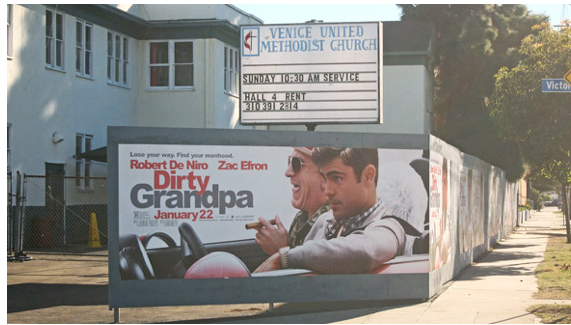CommentsBILLBOARD WATCH-In April of this year, the Los Angeles Department of Building and Safety issued a permit for temporary construction fence signs at the site of a church on Lincoln Blvd. in Venice. Those signs have since advertised movies, TV shows, and Airbnb to an audience of motorists on one of the most gridlocked thoroughfares on the west side of the city.
Lincoln Blvd. is also a Community Design Overlay (CDO) District, with standards and regulations that include a ban on new billboards and off-site signs. Since none of the signs plastered on some 200 ft. of plywood attached to a chain link fence at the edge of the church property have advertised products or activities available at the church, they’re clearly off-site signs and thus prohibited by the CDO.
So why would the building department issue a permit for those signs? Before that permit was handed to the sign company, the City Planning Department had to provide a “clearance” attesting to the fact that the signs wouldn’t conflict with any zoning regulations. So one might think that the CDO’s ban on off-site signs would have prompted a thumbs down on the permit.
But no. The planning department issued the clearance on the grounds that the off-site sign ban in the citywide sign ordinance contains an exception for temporary signs, and that this exception applies to the Lincoln Blvd. CDO.
This makes sense only if facts are ignored and logic twisted. One, the sign permits were issued under a special ordinance allowing advertising signs on fences surrounding construction sites and vacant lots. These signs at construction sites can remain for the duration of the site’s building permit or two years, whichever is less, and there are specific limits on their size, number, and spacing.
In contrast, signs permitted under the citywide sign code’s temporary sign exception can only remain for 30 days at a time, with a cumulative annual limit of 90 days. There are also size limits that are proportional to the street frontage of the property.
The total square footage of the signs at the church property on Lincoln Blvd is considerably greater than that allowed under the temporary signs provision of the citywide sign code. And the signs have violated both the 30-day limit and the 90-day annual limit. Yet the building department has declined to cite those violations because the signs comply with the provisions of the permit issued under the ordinance that allows signs on construction walls.
Confused yet?
The signs violate the CDO’s ban on off-site signs and they violate the size and time limits of the temporary sign regulations, yet the two responsible city agencies regard them as legal.
In other words, black is white and up is down.
To add insult to injury, the Lincoln Blvd. CDO also has design standards stating that fences and walls should not front Lincoln Blvd., and any such fences required by code should be no more than 42 inches high. These provisions are intended to enhance the visual quality and the pedestrian friendliness of the boulevard.
The plywood wall that provides the backing for the church property signs is eight feet high.
Furthermore, there is no sign of any construction activity at the site, which includes the church, a separate auditorium building, and a parking lot.
(Dennis Hathaway is the president of the Ban Billboard Blight Coalition and a CityWatch contributor. He can be reached at: [email protected].) Prepped for CityWatch by Linda Abrams.
Sidebar
Our mission is to promote and facilitate civic engagement and neighborhood empowerment, and to hold area government and its politicians accountable.

 CityWatch Los Angeles
Politics. Perspective. Participation.
CityWatch Los Angeles
Politics. Perspective. Participation.
20
Tue, Jan
















